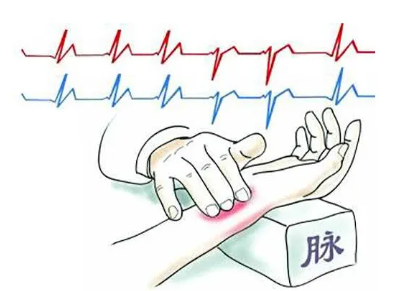Click the blue text to follow us

Pulse Diagnosis generally refers to pulse examination, commonly using the “cun kou diagnosis method,” which involves palpating the pulse at the wrist. The characteristics of a normal pulse include three positions with pulse, neither floating nor sinking, neither fast nor slow, and a regular rhythm. Through pulse diagnosis, one can reflect whether the body’s Qi and blood are sufficient, whether the organ functions are robust, and whether Yin and Yang are balanced, which has clinical significance.
If you need a pulse diagnosis, avoid excessive tension, vigorous exercise, and drinking large amounts of hot water before the examination.
Common Pulse Patterns

Chen Mai (Deep Pulse)
The pulse is located deeper, and light pressure does not reveal a noticeable beat; only with heavy pressure is a distinct pulse felt. Chen Mai indicates interior conditions; a strong deep pulse suggests interior excess, indicating that internal pathogenic factors are strong. If the pulse is deep and weak, it indicates interior deficiency, which refers to deficiency of Zheng Qi. Deficiency of Spleen Qi or Kidney Qi can both be felt as a deep and weak pulse.
Chi Mai (Slow Pulse)
A slow pulse beats less than 4 times per breath, meaning the pulse rate is below 60 beats per minute. This pulse suggests the presence of cold pathogens. Cold causes blood to congeal, and the circulation of blood and Qi slows down, resulting in a slow pulse. A strong slow pulse indicates excess cold, while a weak slow pulse indicates deficiency cold, primarily due to weak Yang Qi that lacks the strength to promote blood circulation. This cold is often caused by Yang cold.
Fu Mai (Floating Pulse)
This pulse often appears in patients with prolonged illnesses, as it indicates external pathogenic invasion that has not been resolved, leading to persistent illness and damage to Yang Qi, resulting in a lighter pulse. Generally, a light touch can feel the pulse, but a heavier touch does not reveal it.

Shu Mai (Rapid Pulse)
The pulse beats quickly, with more than 5 beats per breath, meaning the pulse rate is above 90 beats per minute. The rapid rate of Shu Mai is caused by external pathogens invading, or an imbalance of Yin and Yang in the body, leading to insufficient essence, blood, and fluids. Shu Mai is a Yang pulse, indicating heat conditions. Due to heat disturbing the heart, it can cause mild restlessness or severe mental confusion and delirium.
Xu Mai (Weak Pulse)
This pulse generally indicates body weakness, with insufficient Qi and blood. The pulse appears weak and floating; at this time, it is recommended that patients scientifically supplement their bodies, eat more nutritious foods and fruits, and recover quickly to replenish Qi and blood.
Hong Mai (Surging Pulse)
The pulse is wide and fluctuates greatly, like surging waves. When the pulse rises, it is strong, and when it falls, it is deeper, with significant fluctuations. This pulse indicates excess heat. Excess heat burns, causing Qi and blood to surge, resulting in a pulse that rises and falls dramatically.

Ru Mai (Soft Pulse)
This is also called a soft pulse, which appears floating, fine, and soft, like pressing on a soft sponge. It can be easily felt with light pressure, but not with heavy pressure. Ru Mai primarily indicates dampness as a pathogenic factor. If the pulse is soft and slow, it often indicates dampness obstructing the Spleen. It can also be seen in cases of Qi and blood deficiency.
Xian Mai (String-like Pulse)
The pulse is straight and long, like pressing a guitar string. Xian Mai is one of the most common pulse patterns in clinical practice, associated with liver and gallbladder diseases, various pain syndromes, phlegm fluid retention, and malaria. Xian Mai is the primary pulse for liver and gallbladder diseases; the liver is a rigid organ, and when diseased, the meridians and tendons become tense, resulting in a straight and string-like pulse. Pain syndromes also often present with a string-like pulse, as abdominal pain is often caused by the liver Qi counteracting and attacking the Spleen.
Hua Mai (Slippery Pulse)
The pulse flows smoothly, feeling round and slippery, like beads rolling smoothly from the wrist to the fingers. The slippery pulse indicates phlegm and phlegm fluid retention. Due to phlegm obstructing the interior, when the Zheng Qi is not deficient, Qi and blood can surge, resulting in a slippery pulse. In patients with high fever, heat stimulates blood flow, and the pulse can also be slippery. In women after conception, Qi and blood surge to nourish the fetus, which can also present as a typical slippery pulse.

Se Mai (Choppy Pulse)
The pulse is weak and the shape is fine, with a slow rate and irregular flow. This generally indicates blood deficiency, damage to essence, and fluid loss; additionally, when symptoms such as chest pain, cold limbs, impotence, limb numbness, or chronic bleeding occur, it often indicates the presence of a choppy pulse.
Cu Mai (Interrupted Pulse)
The pulse comes quickly and has irregular interruptions. It is often seen in excess Yang heat combined with Qi stagnation, blood stasis, phlegm retention, food accumulation, and rheumatic heart disease, coronary heart disease, etc. The interrupted pulse must be distinguished from the similar rapid pulse. The interrupted pulse comes quickly with interruptions, while the rapid pulse has a fast frequency without interruptions.
Jie Mai (Knotted Pulse)
The pulse comes slowly and is accompanied by irregular interruptions. Jie Mai indicates excess Yin and Qi stagnation, and the accumulation of masses (visible or invisible masses in the abdomen with a feeling of distension and pain), cold phlegm and blood stasis, and deficiency of Qi and blood.


